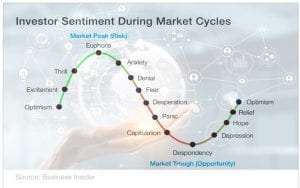
Harnessing Mass Psychology: Unlocking the Path to Financial Mastery
Updated June 29, 2024
Introduction:
Venture into the fascinating realm of mass psychology, which sheds light on the emotional and attitudinal influences that shape collective behaviour. This discipline is crucial for comprehending marketing, politics, and finance decision-making as it decodes societal currents.
By delving into the intricacies of mass psychology, you can understand the mechanisms driving trends and leverage this knowledge to unlock financial success. Crowd psychology reveals the foundations of group decisions, trends, and events across various fields, offering a key to comprehending collective behaviour and improving decision-making in all aspects of life.
Discover the potent synergy of individual minds merging into a formidable force. Understanding mass psychology can become a beacon of success in generating wealth and mastering decision-making.
Decoding Mass Psychology: Insights from Contrarian Thinkers
To be wise is to be open; to be open is to be knowledgeable; to be knowledgeable is to understand that you really know nothing. Sol Palha
Mass psychology, the study of how significant group dynamics influence individual behaviour, has profound implications in various fields, particularly in investing. This exploration delves into the underbelly of group behaviour and decision-making, highlighting the dangers of conformist thinking and the power of contrarian strategies. By understanding the driving forces behind herd mentality, individuals can leverage this knowledge to make bold, informed decisions against the grain of popular opinion.
Historically, mob psychology has shown that humans often do not act rationally in decision-making; emotions, biases, and cultural influences frequently override logical thought. This leads to herding behaviour, which can have significant implications, especially in financial markets. For the contrarian investor, recognizing and understanding these patterns is crucial for making well-informed decisions that diverge from the majority.
Gustave Le Bon, a pioneer in crowd psychology, argued that crowds exert a hypnotic influence over their members, leading to irrational and emotionally charged behaviour. According to Le Bon, the crowd’s anonymity encourages individuals to yield to instincts they might restrain in isolation. This insight is particularly relevant in financial markets, where investor sentiment can drive market swings disconnected from fundamental values.
Emile Durkheim, another critical figure in sociology, introduced the concept of collective effervescence, which describes the energy generated by a gathering of people, leading to a sense of emotional communion. Durkheim’s analysis suggests that such collective emotions can significantly influence economic behaviour, leading to market phenomena such as bubbles and crashes. His work underscores the importance of understanding the social underpinnings of financial actions and the potential pitfalls of collective sentiments.
Mark Twain, renowned for his wit and insights into human nature, famously advised, “Whenever you find yourself on the side of the majority, it is time to pause and reflect.” This sentiment captures the essence of contrarian thinking—questioning the status quo and looking for value where others see none. Twain’s admonition serves as a reminder of the potential rewards of independent thinking, especially in environments where herd behaviour is prevalent.
Navigating the markets with a contrarian approach involves recognizing when pessimism or optimism among the masses reaches extremes. Buying undervalued assets might be a reasonable time when the market is overly pessimistic. Conversely, when optimism is peaking, it might be wise to sell. This strategy requires a deep understanding of both market conditions and human psychology.
The dot-com bubble of the late 1990s and the 2008 financial crisis serve as cautionary tales about the dangers of following the crowd. During these periods, herd mentality led to inflated asset prices and irrational market behaviour, resulting in significant financial downturns. These historical examples highlight the importance of a contrarian mindset in identifying and avoiding potential market pitfalls.
Understanding Mass Psychology in Markets
Mass psychology shapes investment landscapes, often dictating market trends and investor behaviour. This psychological phenomenon, where group members influence each other, can lead to irrational market movements such as bubbles and crashes. The dot-com boom of the late 1990s exemplifies how euphoria can drive market valuations to unsustainable levels, only for them to crash when reality sets in. Contrarian investors, who analyze and understand these behavioural patterns, often position themselves to capitalize on the market’s overreactions. By going against the grain, they avoid the pitfalls of herd mentality and reap substantial rewards when the market corrects itself.
The Internet sector during the 1990s serves as a prime example. While the masses were initially sceptical, contrarian investors recognized the Internet’s transformative potential and made early, strategic investments. As the market sentiment shifted and the masses poured in, these early investors were well-positioned to benefit from the surge in valuations. However, recognizing the signs of an overheated market, they exited at the peak, securing profits before the inevitable crash. This cycle of boom and bust underscores the importance of understanding mass psychology and the advantages of a contrarian approach.
Leveraging Group Psychology for Contrarian Investing
Group psychology is not just about understanding when to enter or exit the market; it’s also about recognizing the less obvious investment opportunities that others might disregard. Historical instances like the Tulip Mania and recent events like the 2008 financial crisis show how collective euphoria can lead to economic bubbles. Savvy investors use this knowledge to identify moments when the market sentiment is at extreme highs or lows, which often signals a potential reversal.
Experts in group dynamics, such as Gustave Le Bon, highlighted how crowds operate under collective hypnosis, making decisions based on emotion rather than rational thought. Emile Durkheim’s theory of collective effervescence further explains how communal events can lead to heightened emotional reactions, influencing investor decisions. These insights are crucial for investors aiming to understand market movements and capitalize on the cyclical nature of mass investment behaviours.
Moreover, Mark Twain’s famous advice to “pause and reflect” when one agrees with the majority offers a timeless strategy for contrarian investing. It reminds us that popular opinion in the market often signals an impending downturn and a need to reassess one’s investment stance.
Maximizing Profits: Integrating Mass Psychology and Technical Analysis
Mass psychology is crucial for understanding market trends and investor behaviour, particularly in identifying collective emotional states like greed, fear, euphoria, or panic. These emotional undercurrents can significantly influence market movements, offering strategic entry and exit points for informed investors. By recognizing these patterns, investors can anticipate shifts in market dynamics, providing a competitive edge in trading and long-term investment strategies.
Charlie Munger, a proponent of understanding psychological influences, emphasizes the importance of contrarian thinking. He suggests that investors often benefit from going against the crowd, primarily when market behaviours are driven by irrational exuberance or undue pessimism. Munger’s insights encourage investors to question herd mentality and look for opportunities where the crowd’s emotions have skewed market prices away from intrinsic values.
Technical Analysis and Market Timing
Integrating technical analysis with mass psychology can enhance an investor’s ability to time the market effectively. Technical analysis provides a framework for interpreting market data and identifying potential trends and reversals through patterns and indicators. When combined with an understanding of mass psychology, technical analysis helps investors pinpoint moments when the market sentiment is at odds with technical signals, such as overbought or oversold conditions.
Another legendary investor, Peter Lynch, advocates using technical analysis and an understanding of market psychology to improve investment decisions. Lynch’s approach involves looking for discrepancies between market sentiment and actual market performance, providing a basis for contrarian investment decisions that can lead to substantial gains.
Jakob Fugger, known as one of the wealthiest men in history, utilized an early form of psychological insight to dominate the financial markets of his time. Fugger’s success was partly due to his deep understanding of human behaviour and market sentiment, which he used to outmanoeuvre other traders and secure lucrative deals. His strategies included careful observation of market trends and a keen understanding of the motivations driving other investors, which is reminiscent of modern psychological and technical analysis techniques.
These are all forms of what the psychos themselves would call if they faced their condition frankly, rhetorical over compensation. James Thurber 1894-1961
Conclusion
Michael Montaigne, a philosopher known for exploring human nature, provides timeless insights into mass psychology through his poignant quotes. His observations offer a deep understanding of the collective mindset, which is crucial for navigating social dynamics and personal growth.
Montaigne famously noted, “Ignorance is the softest pillow on which a man can rest his head,” highlighting the comfort people find in unawareness, which often leads to a herd mentality. He emphasized the importance of self-awareness and personal integrity by saying, “A wise man never loses anything if he has himself,” suggesting that true wisdom and security come from within, not from the approval or acceptance of the crowd.
His approach to education was holistic. He believed every interaction, whether a jest from a young attendant or a casual conversation, contributes to one’s learning and shapes a more rounded human perspective. This idea supports the notion that understanding diverse human behaviours and motivations enhances one’s ability to decipher group psychology effectively.
Montaigne also reflected on the ageing process, “Time etches more creases in mind than on the countenance,” implying that true wisdom and depth of understanding accumulate with life experiences, enriching one’s insights into human behaviour and mass psychology.
Carl Jung’s thoughts resonate with Montaigne’s, particularly regarding the psychology of crowds. Jung described how individuals in a crowd descend to a lower moral and intellectual level, driven by unconscious, primal forces. This aligns with Montaigne’s views on the importance of individual thought and the dangers of collective influence.
Integrating these philosophical insights with modern investment strategies, as suggested by figures like Charlie Munger and Peter Lynch, emphasizes the value of contrarian thinking. Munger advocates for going against the crowd when investing, a principle Montaigne’s scepticism of mass approval would support. Lynch’s investing strategy is based on solid, often contrarian analysis rather than popular sentiment, which mirrors Montaigne’s call for independent judgment.
In essence, Montaigne’s wisdom, when applied to understanding mass psychology, provides a robust framework for personal development and decision-making in various aspects of life, including finance. His teachings encourage a reflective, discerning approach to both personal growth and professional endeavours, advocating for a life led by self-knowledge and independent thought.
From Our Archive: A Diverse Range of Articles to Explore

Stock Market Bull 2019: Embrace the Trend, Ignore the Noise

Peak Oil Theory: Unmasking a Potential Price Gouging Scheme

Profits Unlimited: Myth or Money-Making Reality?

Random Thoughts: Web of lies Woven by Powerful Individuals

History of Financial Markets: Masses in the Dance of Destiny

Nasdaq TQQQ: Amplified Returns and Double-Edged Risks

1970s Inflation vs Today – The Good, the Bad, the Now

How to Buy Stocks Online Without a Broker: A Smooth Guide

Stock Market Correction History: Decoding Illusions Behind Crashes

Balancing Strategy and Skullduggery in Stock Price Manipulation

Unlock the Secrets: Learn How to Trade Options like a Pro!

Bitcoin Crash: The Bull’s Demise or Rebirth?

It’s the Economy, Stupid: Not Exactly

Tomorrow’s Stock Market Prediction: A Silly Pursuit?




Thanks for the great blog post!
I’ve actually created a similar article about ‘7 Trading Psychology Ideas from Dr. Brett Steenbarger.
I think you’ll love it and it’d be beneficial to your followers, as well.
Here’s the link if you’d like to take a look:
http://www.intelligenttrendfollower.com/trading-psychology-brett-steenbarger/
Jay